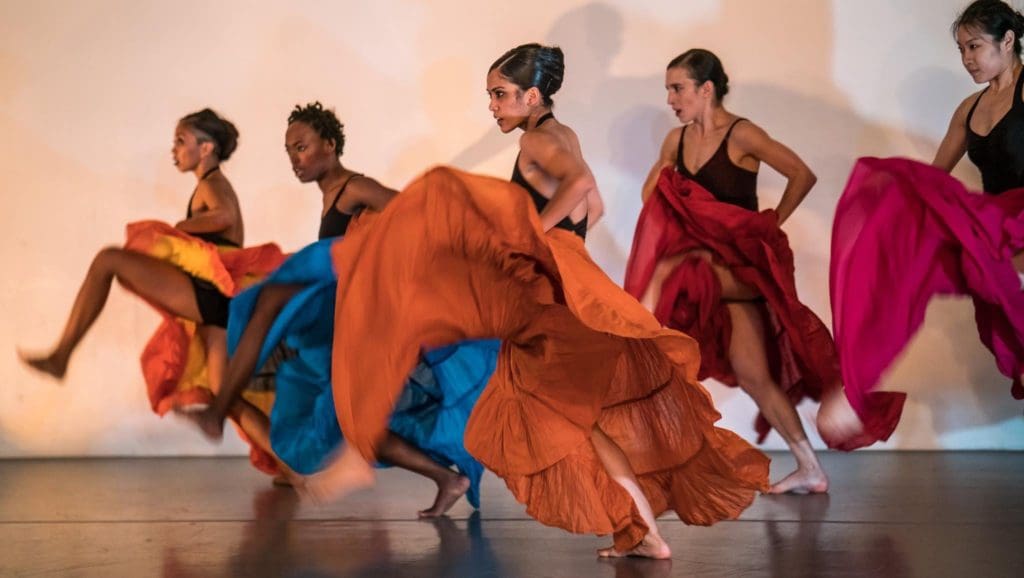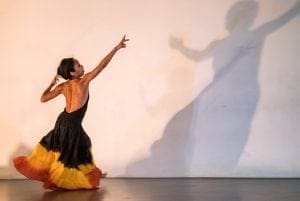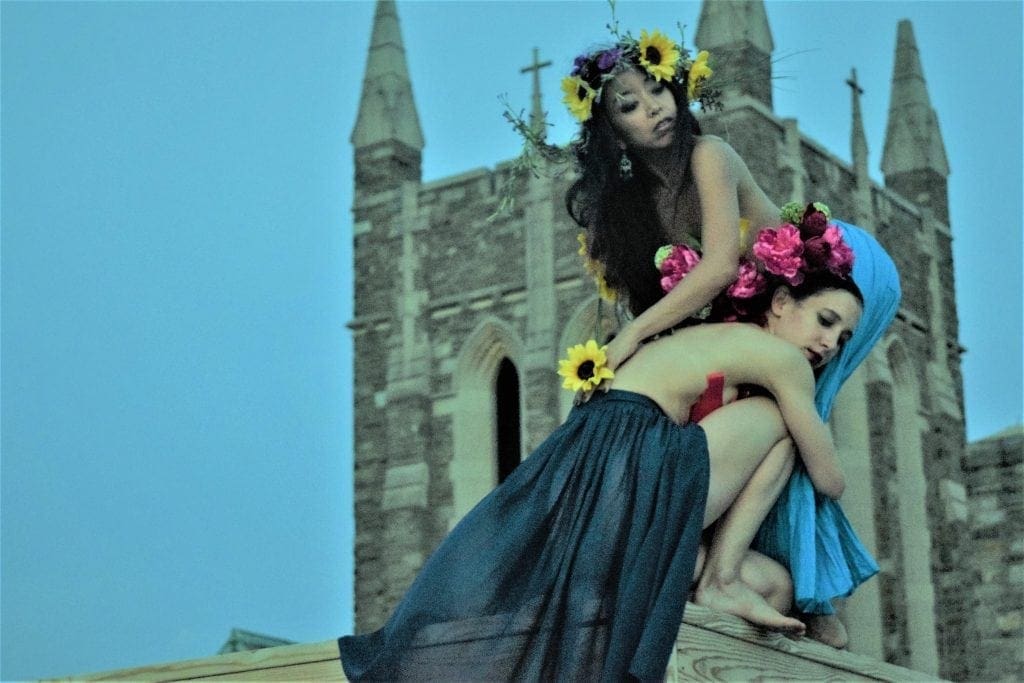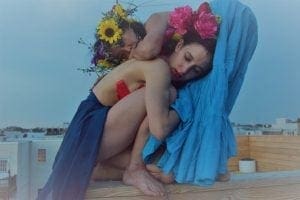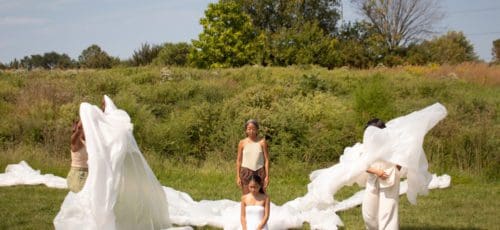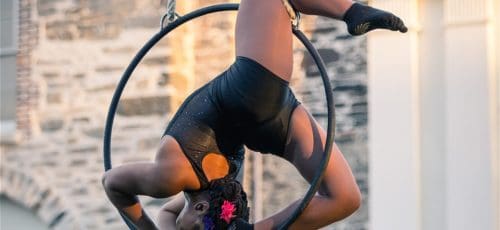Filipino Folkdance, Contemporary Ballet, and Motherhood: Annielille Gavino Kollman’s HERstory
What do you get when you combine modern choreography, folkdance polyrhythms, and a baby? The dances of Annielille Gavino Kollman bring together eastern and western styles, while incorporating many other disciplines, and using a group of dancers diverse in both race and generation. Her newest work, HERstory, is a three-part production that investigates the theme of motherhood and culture, and is supported by the Small But Mighty Art Grant. Annielille’s dance is about her homeland (the Philippines) as a mother and acts as a celebration and portrait of the women there and around the world. She first learned dance as a folkdancer, and now incorporates the styles from her country into contemporary movements. Much of the work is autobiographical, expressing her experience as a mother and as a Filipina woman, but it also includes the backstories of the other dancers, who contribute vibrant rhythms by clapping, stomping, and yelling. Additionally, HERstroy features spoken word through poetry written by the dancers and Lenora Howard, film projection by Jasmine Lynea Callis, and music composed by Maya Simonee.
Born in the Philippines, Annielille lived there until coming to New York after college. She attended the The Ailey School of dance in 2000, which caters to minorities who were often overlooked in the world of ballet and modern dance. She left the country “on impulse” but she also left to escape extremely difficult circumstances. She was tired of being silenced as a woman, and of experiences of abuse by men. “I was too vocal. I think that was the problem for them. I was too strong to be a submissive wife.” She had been dancing since she could remember, and was a highly skilled folkdancer. “It was just a way for me to get out of the country so I just followed that, because I was good at it. It became cathartic to me, too, so I just kept doing it.”
 After studying at Ailey, she danced around the United States for different companies, touring in Colorado, and then in Texas. Later she moved to Virginia, where she found very little creative dance, and a society that was less accepting of her than they had been in New York. “It was very segregated,” she says. “Being in a place where I saw Confederate flags every day of my life, I started to make art. I became a political artist at first, and more of a performance artist.” She had her daughter, and started teaching her dance. “When I didn’t have an outlet for dance, I started teaching her texture, colors, and letters through dance.” She also started choreographing for a Filipino folk dance group, and began teaching her folk dances. She moved to Philadelphia two years ago, a welcome change. “I liked the grit, and a little bit of a faster pace. I love the row houses, and the little streets, where people can connect easier than in wider, suburban space. I feel more at home in cities like this.” Once in Philadelphia, she started dancing for Kun-Yang Li/Dancers, and soon, creating her own projects.
After studying at Ailey, she danced around the United States for different companies, touring in Colorado, and then in Texas. Later she moved to Virginia, where she found very little creative dance, and a society that was less accepting of her than they had been in New York. “It was very segregated,” she says. “Being in a place where I saw Confederate flags every day of my life, I started to make art. I became a political artist at first, and more of a performance artist.” She had her daughter, and started teaching her dance. “When I didn’t have an outlet for dance, I started teaching her texture, colors, and letters through dance.” She also started choreographing for a Filipino folk dance group, and began teaching her folk dances. She moved to Philadelphia two years ago, a welcome change. “I liked the grit, and a little bit of a faster pace. I love the row houses, and the little streets, where people can connect easier than in wider, suburban space. I feel more at home in cities like this.” Once in Philadelphia, she started dancing for Kun-Yang Li/Dancers, and soon, creating her own projects.
HERstory will be a part of this year’s Fringe Festival along with Evalina Carbonell’s Milk. The two shows will be performed together to make up Mujeres and both are works about motherhood. Annielille has been making works on motherhood for a while and her interpretation of the theme has been evolving. In this show, the mother “is not necessarily a person, it’s the homeland. I was close to my mother, and the indigenous people, they’re also my mothers. It was that thought, and wanting to share that with my daughter.” She went back to the Philippines last year to visit her mother, for the first time in seven years. That was when she had the idea to create the show. Back in the states, her daughter had a dance photoshoot outdoors. Annielille gave her a large plastic sheet to play with while she danced. As the wind blew around her, “It looked like water, and then, it became like birth.” This inspired her further, and she decided to use the motif in the show. “It started with me in the womb, and what water is to me, besides the fact that I come from the Pacific, which is Mother Ocean. I came from the womb, and I gave birth, and she came from the womb. I created, with water.” The show is arranged in three parts, with this element of the plastic sheet in the first section. “The first part became about honoring my indigenous people.” She taught chants to the dancers as well as footwork. “A lot of them were not really familiar with footwork. In contemporary dance, people don’t really use footwork or polyrhythms, especially in more westernized training. So this is stepping away from eurocentricity.”
While looking for music about water, she found a choral hymn, which led her to make the second part about the coming of Christianity to the Philippines by way of the Spanish. “I did more research, and I found that my people were predominately a matriarchal society before the Spanish came. Women were the priestesses and the chieftains. We were the healers. We were openly sexual, and our goddesses were goddesses of snakes.” She found some of this out from a cultural anthropologist who was living near her mother’s house in the Philippines. “Her name was Dr. Alicia Magos,” she says, “and she said that women would have sex like they were snakes. When the Spanish came, they thought this was sacrilegious. They brought purity and chastity to us, but we were removed from this wonderful sense of sensuality, which we enjoyed, and now it’s not supposed to be enjoyed by us. It’s supposed to be a gift to men.” In this section of the show, she incorporates spoken word, each dancer with their own poem that begins with “Bless me Father, for I have sinned.” Evalina is in this production as well as her own, and is a new mother. One time when she brought her baby to rehearsal, she went to pick her up as she started crying. “I said, ‘Just keep her there, let her do her thing, and let’s see what will happen.’ How can we design it where she’s there?” The section also includes a duet that Annielille has with a man, articulating experiences of abuse. Women are stationed around the duet, but say nothing, “because it’s taboo. It’s too sexual. And again, I blame my colonizers. There’s a reason why they didn’t speak up, because they were too embarrassed.”
 The third and final part of the show is “Madre,” which has taken the form of a funeral. “But in mourning, there is release,” she says. “It’s very spiritual if you think about it. There’s creation, destruction, and restoration. Even in mourning, it doesn’t end there, because there’s life.” Even though the premise is dark, the work is hopeful. “There is still love, and there is still rebirth. There’s a recycled energy there, of friendship.”
The third and final part of the show is “Madre,” which has taken the form of a funeral. “But in mourning, there is release,” she says. “It’s very spiritual if you think about it. There’s creation, destruction, and restoration. Even in mourning, it doesn’t end there, because there’s life.” Even though the premise is dark, the work is hopeful. “There is still love, and there is still rebirth. There’s a recycled energy there, of friendship.”
Working with film and other media is exciting for Annielille, who likes to include many disciplines in her productions. She brings in elements from folk dances, intertwining them with her training in ballet. “I always include folk and body percussion. I always include things that are me.” She expands this multifaceted work to include other disciplines as well, including poetry and film projection. “I get bored with just dance, even though I am a dancer! I need to take my eye into a different world.” She also makes it her goal for her company to be as diverse as possible. “I’m very big on community; it’s like a metaphor to me. And I also love intergenerational art. That’s why I have the baby in the show, and my nine-year-old daughter. I also factor in race, and I always make sure every kind of body is represented.”
The celebration of mothers and of all women is important for Annielille, who faces many challenges as an artist with a young child. She is always trying to find ways to spend more time with her daughter, as well as enough time creating and teaching dance. Last year, she was accepted into a competitive residency program in Vermont. However, when she asked if she could bring her daughter, they refused to let her, and she had to turn the residency down. Difficulties range from these larger events to day-to-day conflicts. “She wants to do gymnastics, but I have rehearsals. So it’s always compromising. We have to pick something when I’m not working.” While some organizations are more understanding, there is still a huge lack of support. She feels that even liberal, progressive foundations, do not have enough leeway for mothers, and rarely consider the challenges they face when taking care of their children while trying to create art. “There should be more awards or grants for mothers who are still in the field, because most of us change careers once we have kids.”
Happily, she has found places in Philadelphia that are flexible and understanding of her situation. “I work for people who are very willing to accept me. At Kun-Yang, they are very supportive, and they let her come.” The city has also been a great place for her as an interdisciplinary artist. “I’m really in heaven here. I walk in between worlds. I love going to music, poetry events, and hanging out with many cultural groups and organizations.” She loves combining and mixing together all of these different elements into one production. “It’s like jambalaya!”
Mujeres
Gavino + Carbonell
$20 / 90 minutes
Chi Movement for the Arts
1316 South 9th Street
Sept 22 + 23 at 8pm
Sept 24 at 3pm + 7pm
—Isabella Siegel
Photos: Mike Hurwitz (banner, first, second, and second to last photos), Edgar Adino (third and last photos)
Video: Jasmine Lynaea Callis

